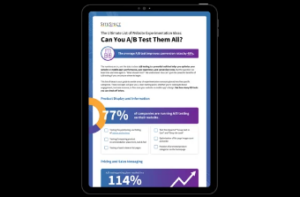4 Holiday Site A/B Testing Strategies That Improve Conversions
By SiteSpect Marketing
November 15, 2013
Share
If you are like most digital marketers today, you are doing everything you can to increase conversion rates and maximize the ROI of your website. This article explores holiday A/B testing strategies for maximizing conversion drivers and minimizing conversion barriers—the elements that are either helping or hindering the effectiveness of your website. Once you thoroughly understand these strategies, and the principles behind them, you can A/B test and optimize the elements associated with them to improve your web and mobile conversions.
1) A/B test Your Value Proposition
Your company, products and website should all have a clear value proposition; your success depends on defining exactly what it is. A value proposition is simply a promise of value and a reason for someone to take action.
It should describe and address the tangible and intangible benefits and costs of doing business with you, buying a particular product or using your website. For example, when you purchase a particular product, you are giving up the choice to purchase an alternative product, which is an intangible opportunity cost.
In describing and addressing tangible and intangible benefits and costs, your value proposition should answer:
- What’s in it for me (the customer)? How does this company/product/service solve my stated (explicit) or understood (implicit) problem, give me what I need and/or fulfill my wants?
- Why should I do business with you?
- Why now?
Value propositions are communicated through copy, images and user experiences that can be A/B tested and optimized on your Web and mobile sites.
2) Optimize for Relevancy
Providing a relevant experience, where the information on the website matches the goal of the visitor, is one of the most important things you can do to improve online conversions. In fact, it’s so important that it’s the No. 1 source of consumer dissatisfaction on the Web, according to the “Webreep Annual Online Consumer Behavior Report, 2012-2013,” which analyzes website visitor data from more than 5,000 websites in 30 different industry categories.
Visitors arrive at your website through a variety of online channels: pay-per-click (PPC) and organic search; email campaigns; banner ads and print ads; among others. Once there, they need to be able to do/buy/learn what they came for.
If their entry leaves them cold because they don’t see anything relevant to what drove them there, they’re most likely to leave, having wasted their time and your marketing dollars.
3) Experiment with Consistency
This is a very interesting strategy, which leverages the notions that:
- People act consistently with their values, attitudes and beliefs; and
- People will change their behavior based on how they believe they are being perceived.
What that means is the more you can make an online experience consistent with these values, attitudes, beliefs and perceptions (and, therefore, become more personally relevant to them), the better luck you’ll have at influencing behavior.
While this is the cornerstone to personalization, which is often based on behavior or customer profile, what’s more interesting is A/B testing and optimizing experiences based on perception.
For example, visitors who are treated like high-value customers, and who then believe they are high-value customers, tend to act like high-value customers. Don’t believe it? Test it!
4) A/B Test Elements/Experiences to Reduce Anxiety
The anxiety created during an online experience is usually related to doubts, hesitations, and second thoughts about credibility and trust, and the easiest way to alleviate anxiety is to address these potential concerns upfront by A/B testing different content related to your privacy policy, site security, order fulfillment and shipment timeframes.
Summary
There are a multitude of elements on your website that you can A/B test and optimize to improve conversions during the holiday shopping season.
The process of A/B testing reveals not only what works and should be implemented, but also what doesn’t work and should be avoided. Every website idea, whether content, functionality or campaign-related, should be put to the A/B test to determine if it helps or hurts the visitor experience.
While some new ideas lift conversions, others fail—sometimes significantly. But even with these failures, there is definable knowledge gained over what to avoid the next time. The ability to A/B test a new idea and “look before you leap” is an unmistakable advantage that breaks the constraints on marketing innovation.
To learn more about SiteSpect, visit our website.
Share
Suggested Posts
Subscribe to our blog:






